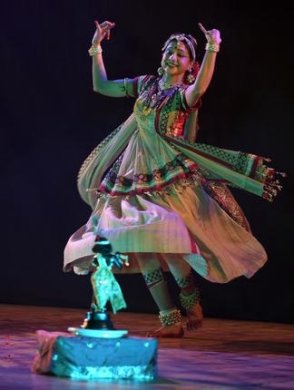
|   |

|   |
Meera by Urmila Sathyanarayanan, Shankar Kandasamy and team - Priya Das e-mail: priyafeatures@gmail.com May 8, 2015 Urmila Sathyanarayanan, with Shankar Kandasamy as artistic director and co-performer, and team presented Meera at the Cubberley Auditorium, Palo Alto, California on May 1, 2015. The production was a fusion of Bharatanatyam (with some deliberate Kathak influences), theater, English commentary, and multi-lingual songs. It would have been appreciated if Urmila or Shankar had addressed the audience with opening or closing remarks. One looks forward to getting a glimpse into the production, the how and why of it, or inspirational moments, to personally connect us to the theme.  Photo: SR Raghunathan
Meera began strong on the audio-visual aesthetic, with a commentary preceding four of the company dancers beautifully costumed in North Indian style celebrating bhakti to Lord Vishnu. The introductory dance had pleasing formations, consistent symmetry, and lively gyrations but the transition from bhakti to shringara-bhakti was a bit abrupt; one minute the dancers were praying to Vishnu, the next they were intertwining hands as Krishna and gopis. We were then introduced to the raison d’être of Meera’s devotion- her initiation in the family’s immersive worship of Vishnu and her mother’s chance remark to a young Meera that the idol of Krishna was her husband.This was portrayed in great detail, forming a foundation for the rest of the presentation. The growing attachment Meera forms to an imaginary Krishna as her steadfast companion was believably brought to life. The added touch of a young Meera cajoling Krishna to sleep and then a grown-up Meera cajoling him awake was evidence of the attention to storyline. On the whole, Meera was a fitting choice as a nayika, the sthayibhava of innocence and bhakti was embodied in Urmila’s petite body structure and cherubic face. The progression of Meera’s engrossment in Krishna was masterfully expressed in the storyline and by Urmila. She escapes into her imagination when she realizes the futility of convincing her father that she is already wed to Krishna; she yearns for Him after she has performed her queenly duties; she dismisses the insults from her in-laws by losing herself in Krishna’s resplendence. Urmila stayed true to character, there seemed to be an aura of Meera all around her, at all times. However, a big distraction was the fact that the idol was always placed on stage-left corner, thus making it possible to only see Meera’s face in profile as she conversed with it. This can be easily corrected by placing the idol (actual or imaginary) on stagefront-center, so the audience can partake of the full experience. Shankar played the characters of Meera’s father Rana, Akbar, and the snake charmer. The last was wonderfully and comically represented in a lokadharmi style. The dancer playing the sister-in-law overdid it a tad but successfully convinced the audience that her allegiance lay with her brother and Meera was of no consequence. With respect to the audio component of the production, a discordant note in the portrayal was the voiceover for Meera; the tonal quality was evocative of a scheming nayika rather than a wonderstruck one. The attempt at a child-like voice for young Meera came off as an exaggeration. Indeed, the need for any dialog is debatable, since the commentary provides a good gist of what is to follow. The female singer was excellent, not only in terms of high quality of singing and bhava, but also in terms of Hindi diction, an essential ingredient in this production. In summary, the storyline, music (featuring Meera bhajans and Tamil poetry), Meera’s portrayal, and group choreography stood out. Meera will appeal to a wide swath of English speaking populace with an interest in the Performing Arts. Priya Das is a writer based in San Francisco Bay Area, USA, covering extraordinary nuances of everyday life with a focus on the performing arts. She is a regular contributor to India Currents, a magazine reaching more than 170K readers on - and offline. Some of her writing is at priyafeatures.com |